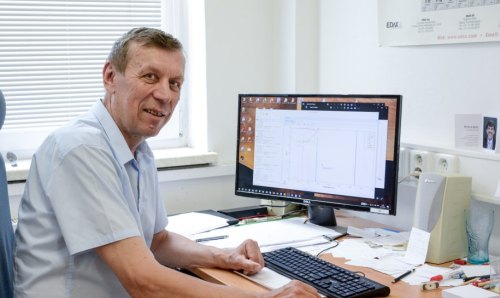Dr. Aleš Kroupa, head of the Structure of Phases and Thermodynamics Group at the IPM, has long been devoted to theoretical descriptions of phase diagrams of binary and ternary systems based on new experimental data. He is also the newly elected Vice Chairman of The Alloy Phase Diagram International Commission (APDIC). What organization is it? Why is it important to the phase diagram community? You can find answers not only to these questions in the interview with physicist Aleš Kroupa.
You have become the new vice-chairman of The Alloy Phase Diagram International Commission. Can you outline the aim and mission of this commission and what your vice presidency entails?
APDIC is a non-profit organization whose main goal is to promote the importance of detailed knowledge of phase diagrams, their systematic evaluation and dissemination of quality information on thermodynamics and phase equilibria of complex systems. An important point is to support their application in industry and academia.
For a closer idea, please describe the structure of the commission. How many members are there? On what basis are its members elected, and how often do they change?
APDIC consists of 18 independent national and international organizations that coordinate the study of phase diagrams in their respective countries and regions. APDIC currently has 28 countries from around the world as members. E.g. For historical reasons, Germany and Austria are united in one society, and the smaller countries of Central and Eastern Europe, including the Czech Republic, are members of the multinational organization Associated Phase Diagram and Thermodynamic Committee.
The cooperation and coordination of members‘ activities is discussed and prepared at the annual meetings of APDIC members. Only the chairman and vice-chairman are elected, who are chosen from the representatives of individual members, there is no fixed term of office set for them, but they usually serve in their positions for 4 to 5 years.
If you had to highlight the main contributions of the commission to the scientific community in the field of phase diagrams, what would they be?
In addition to the above effort to coordinate phase diagram research, APDIC promotes the importance of the information that phase diagrams can offer by presenting two awards each year.
One of them is the Best Paper Award (BPA), which is awarded to the authors of the publication evaluated as the best publication in the field of phase equilibria and thermodynamics in the previous year. The second prize is the Industrial Award (IA), which recognizes outstanding achievements made by industrial enterprises that use a knowledge-based approach and modern strategies in the use of phase diagrams for the development of new materials and technologies, leading to greener production and economic savings. Past recipients include e.g. Rolls Royce Aerospace Engines, Sandvik AB, Hitachi and TATA steels Ltd.
Another activity of the APDIC is the organization of educational seminars on phase diagrams (so-called World Round Robin seminars) for workers from industry and students from related fields.
Phase diagrams accompany you throughout your scientific career. Can you say what fascinates you so much about them and what do you see as their main significance?
I was definitely not interested in phase diagrams from the very beginning of my scientific career. Moreover, my specialization was decided by chance only during my doctoral work. However, I can’t complain, and phase diagrams are a really interesting area where, based on their knowledge, it is possible to predict the behavior of materials, their properties (especially the threat of negative ones), and to solve problems that sometimes arise in practice and within scientific projects. These possibilities have expanded incredibly, especially with the development of computers and theoretical methods for calculating phase diagrams for real multicomponent materials.
In conclusion, I would like to ask about your recommendations for beginning scientists and students. A number of them often literally struggle with phase diagrams. Do you have any advice for them on how to penetrate the secrets of these complicated systems?
With a bit of exaggeration, it could be said that it might be enough to honestly attend basic and advanced lectures on thermodynamics, phase diagrams and their modelling, which exist in all universities. Those „students and budding scientists“ often underestimate the fact that in materials engineering, phase diagrams can come in handy in unexpected situations anytime in the future.
However, everything comes only with practice, so it is necessary not to be afraid to „annoy“ more experienced colleagues with questions, even if you feel that they are a bit clumsy and naive (even stupid). A reasonable expert will not make fun of you, but will rather „show off“. I was the first at the institute to start with their calculations using computers, so I could rely on the advice of those more experienced in the field of experimental FDs, but not for help with their theoretical calculations. Later, I sometimes felt this inexperience, for example at conferences, when I struggled with ambiguities, which after discussion turned out to be relatively simple and logically explainable.
The interview was prepared by Tereza Sojková.





